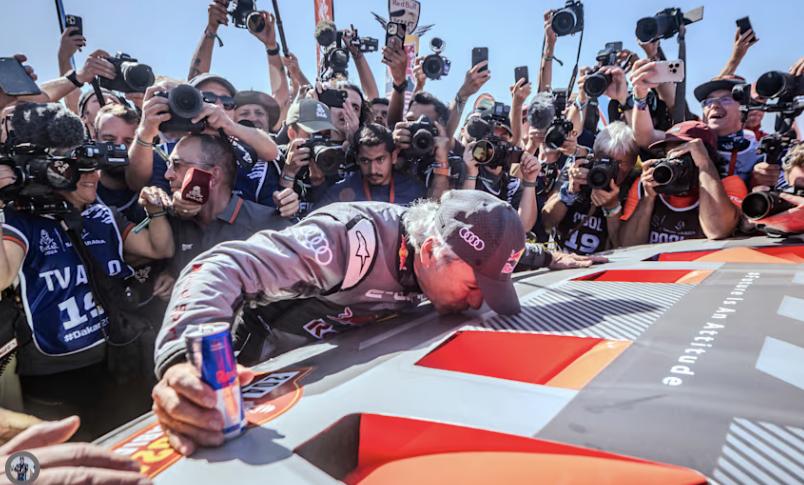
Positive Reviews: Red Bull’s Asset – Light Marketing Model Redefines the Core Competitiveness of Consumer Goods Brands
In today’s highly competitive functional beverage market, Red Bull has verified the underlying logic of the consumer goods industry with its disruptive strategy of “selling 1.267 billion cans without producing a single one” – the construction of brand premium may determine the survival height of an enterprise more than product production. The core of its success lies in accurately grasping the dual – wheel drive model of “asset – light + strong marketing”, providing a classic path for consumer goods enterprises to break through with differentiation.
First of all, Red Bull’s positioning of “marketing as the core” breaks the traditional mindset of consumer goods that emphasizes production and neglects the brand. Since its establishment in 1984, Red Bull’s founder, Dietrich Mateschitz, quickly shifted his focus from formula improvement to marketing. This is not a neglect of product quality but a profound insight into the essence of the industry: the technical threshold of functional beverages is extremely low (the formula only contains basic ingredients such as caffeine and taurine), and the space for differentiation in the production process is limited. What can really form a barrier is the emotional connection between the brand and consumers. Therefore, Red Bull chose to outsource production entirely to the Austrian contract manufacturer Rauch. Even when facing import tax issues in the North American market, it only solved the production problem through a joint – venture approach, always maintaining the “asset – light” nature of the production process. This strategy allows Red Bull to concentrate its resources on the high – value – added marketing process, avoiding the consumption of cash flow caused by heavy – asset investment and circumventing complex issues such as production equipment depreciation and quality control management.
Secondly, Red Bull’s in – depth exploration of “extreme sports + content marketing” accurately hits the “high – efficiency track” of brand communication. While giants like Coca – Cola and PepsiCo are caught in the “sponsorship fee involution” in mass sports events, Red Bull targeted the niche but highly promising field of extreme sports. Extreme projects such as cliff diving, wingsuit flying, and stratospheric skydiving naturally have the characteristics of “high – risk and strong visual impact”. They can not only capture high – frequency exposure of the Red Bull logo through the camera but also deeply bind the brand spirit of “adventure and breakthrough” with the athletes’ “self – challenge” behavior. For example, in the 2012 Red Bull Stratos project, by live – streaming the entire process of an Austrian athlete’s skydive from 39,000 meters above sea level, it not only created a communication miracle of over 1 billion views on YouTube but also transformed the slogan “Red Bull gives you wings” from a slogan into a concrete scenario of “witnessing a miracle”. This model of “creating topics with content and feeding back the brand with topics” has stronger user stickiness than traditional advertising. When consumers see the Red Bull logo in “a jump at the edge of the universe”, what they are buying is no longer just a can of beverage but an identification with the spirit of “breaking the limits”.
Finally, through the ecological layout of “sports + media”, Red Bull has built a long – term moat for brand value. The Red Bull Media House, established in 2007, is not only a producer of event content but also a media matrix covering TV stations, streaming media (Red Bull TV), magazines (The Red Bulletin), and record companies. Its content includes not only its own events (such as more than 1,200 extreme sports events every year) but also extends to documentaries (such as A Jump at the Edge of the Universe), sports culture output (supporting subtitles in 14 languages), and even developing native applications for Apple Vision Pro. This model of “self – produced content + multi – channel distribution” has upgraded Red Bull from a “sponsor” to a “content producer”, further strengthening the cultural attributes of the brand. Data shows that Red Bull’s investment in sports assets such as F1 teams and football clubs has not only achieved “profitability of the marketing department” through sponsorships and bonuses (for example, the Toro Rosso team made a profit of $1.8 million in 2018) but also brought an annual value return of about $300 million through brand exposure. This virtuous cycle of “marketing as revenue” has completely rewritten the traditional perception that “the marketing department is a cost center”.
Negative Reviews: Hidden Worries of Over – Reliance on Marketing and Potential Risks under the Asset – Light Model
Although Red Bull’s success is remarkable, its model also has obvious vulnerabilities. When “marketing supremacy” becomes the absolute dominant corporate strategy, the brand may face the risk of “shaky foundations”; and the complete outsourcing of the production process also poses hidden dangers to product quality and supply chain stability.
Firstly, the singularity of the brand image may limit the market expansion space. The “adventure and breakthrough” image created by Red Bull through extreme sports can attract young and thrill – seeking consumers, but it may also trap the brand in the “labeling” dilemma. For example, its slogans “Red Bull gives you wings” and “Your energy is beyond your imagination” essentially bind the product to “high – intensity scenarios” (such as sports and overtime work), which limits the diversification of consumption scenarios to a certain extent. In contrast, Coca – Cola covers all age groups from children to the elderly with its universal positioning of “happiness and sharing”, and Yuanqi Forest targets female and fitness groups with its “sugar – free and calorie – free” health label. If Red Bull relies on the “hardcore” image of extreme sports for a long time, it may be difficult to reach a wider range of daily consumption scenarios (such as family gatherings and commuting), and may even face the risk of losing users as the target group ages (from “adventurous youth” to “stable middle – aged”).
Secondly, the complete outsourcing of the production process may lead to risks in quality control and the supply chain. Although Red Bull emphasizes that “there are no barriers in production”, the core of functional beverages is “safety” and “stability” – the content of taurine and caffeine must strictly comply with food regulations in various countries. If the contract manufacturer reduces raw material standards due to cost control (such as using low – quality sugar or additives) or causes pollution due to management negligence, it may directly damage the brand’s reputation. For example, in the case of the counterfeit “JHY Bull” seized by the police in Chongqing in 2023, although it was a counterfeit product, it reflects the high imitability of Red Bull products in the market. If the contract manufacturer participates in counterfeiting due to profit – driven motives (or due to ineffective supervision), the consequences will be even more serious. In addition, Red Bull’s production highly depends on a few contract manufacturers such as Rauch in Austria. If the supply chain is interrupted due to geopolitical issues (such as trade wars), natural disasters (such as factory fires), or the contract manufacturer’s own management problems (such as bankruptcy), its annual global sales of 1.267 billion cans will face the risk of “supply interruption”, and the high cost of self – built production capacity may put Red Bull in a passive position.
Thirdly, the sustainability of marketing investment faces challenges. Red Bull’s high premium (the retail price is 40 times the cost) depends on continuous high – exposure, but the “scarcity” and “high – risk” nature of extreme sports may drive up marketing costs. For example, the success of the Red Bull Stratos project is difficult to replicate. The “shock” of stratospheric skydiving requires extreme technology (such as spacesuits) and resources (such as space capsules), and the investment in subsequent similar projects may increase exponentially. In addition, with the popularization of action cameras such as GoPro, the production threshold of extreme sports content has decreased, and users’ sensitivity to “high – risk pictures” may decline. The brand value conveyed by Red Bull through “adventure scenarios” may be diluted. More importantly, if consumers gradually realize that “the energy effect of Red Bull” has no direct connection with the “breaking the limits” advertised (for example, American consumers once sued Red Bull for “not growing wings”), the brand’s “emotional premium” may face a trust crisis.
Advice for Entrepreneurs: Balance “Product Power” and “Brand Power” to Build Sustainable Core Competitiveness
The case of Red Bull provides important inspiration for entrepreneurs: in the consumer goods field, the construction of brand premium is the key to an enterprise’s survival, but this process needs to be based on the “product foundation” and be vigilant against the trap of “marketing dependence”. Combining the experience and lessons of Red Bull, entrepreneurs can optimize their strategies in the following three aspects:
Clarify the Boundary of “Asset – Light” to Avoid Loss of Control in the Production Process
Although Red Bull’s asset – light model is efficient, it needs to be based on the premise that “the production process can be strictly controlled”. If entrepreneurs choose to outsource production, they need to pay attention to three points: first, choose contract manufacturers with complete qualifications and strict quality control (compliance can be ensured through third – party audits); second, sign detailed quality agreements (specify raw material standards, testing processes, and liability for breach of contract); third, retain a certain amount of self – owned production capacity or alternative suppliers (such as Red Bull’s joint – venture factory in North America) to avoid the risk of a single – source supply chain. For product categories with low technical thresholds (such as beverages and daily necessities), the path of “production outsourcing + brand leadership” is feasible, but product safety should always be the bottom line.Accurately Position “Differentiated Scenarios” to Avoid Brand Labeling
Red Bull’s success stems from its accurate entry into the “extreme sports scenario”, but entrepreneurs need to note that the scenario selection should take into account both “communicability” and “expandability”. For example, if the “office overtime” scenario is selected, the scenario can be extended from “temporary refreshment” to “daily replenishment” by cooperating with convenience stores in office buildings and launching small – package products; if the “fitness” scenario is chosen, a wider range of health – conscious people can be covered by cooperating with gyms and launching low – sugar versions. The key is to find a balance between the “unique label” and the “universal demand” to avoid the brand being “locked” by a single scenario.Build a “Content Ecosystem” Instead of “Single – Time Marketing” to Improve Brand Resilience
Red Bull’s media layout (such as Red Bull TV and documentaries) is the key to its brand resilience – content can not only continuously output brand value but also generate revenue through membership subscriptions and advertising sharing. Entrepreneurs can learn from this idea and transform marketing activities into “content assets”: for example, organize events in vertical fields (such as niche sports and handicraft competitions) and record the process through short videos, live – streaming, and documentaries; establish a brand – owned media matrix (such as official accounts on WeChat, Douyin, and Xiaohongshu) and continuously output user stories (such as “real cases of achieving goals with the product”). This “content ecosystem” can not only reduce the dependence on external advertising but also enhance brand stickiness through user participation.
In conclusion, Red Bull’s model of “not producing beverages but selling them globally” essentially redefines the “core value of consumer goods” – in fields with limited technical thresholds, the emotional premium of the brand can determine the ceiling of an enterprise more than the physical function of the product. However, entrepreneurs need to clearly recognize that marketing is an “amplifier” rather than a “substitute”. If they neglect the product foundation (such as safety and stability) or rely too much on a single label (such as extreme sports), even the strongest marketing cannot support the long – term development of the brand. Only by finding a balance between “product power” and “brand power” can a truly sustainable core competitiveness be built.
- Startup Commentary”Building LLMs: The Knowledge Graph Foundation Every AI Project Needs”
- Startup Commentary”The 17th Year of Tmall Double 11 and the New Map Rewritten by AI”
- Startup Commentary”How to Prepare Your Data for Artificial Intelligence”
- Startup Commentary”Small and Medium-sized Banks: “Cutting the Tail” in Loan Assistance”
- Startup Commentary”The Six AI Giants on Stage: AGI Is No Longer a “Future” Thing”





